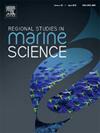Predicting the potential habitat suitability of mangrove bioindicator species- Telescopium telescopium (Linnaeus, 1758) through MaxEnt modelling
IF 2.1
4区 环境科学与生态学
Q3 ECOLOGY
引用次数: 0
Abstract
Mangrove ecosystems are blessed with molluscs that are a key component as bioindicator species and measure the environment's health. The most prevalent and most sensitive bioindicator species in mangroves worldwide is Telescopium telescopium. Habitat loss is the evitable cause of species extinction, however, the species distribution and loss (here, T. telescopium) due to climate change factors throughout the globe is still not clear. The maximum entropy species distribution model (MaxEnt) was used to investigate the present habitat suitability distribution of T. telescopium population. Based on the results, T. telescopium showed high potential distribution in South-East Asia which is dominated by mangrove regions. The MaxEnt model showed an AUC (area under the curve, "Sensitivity vs. Specificity") value of 0.962, indicating its high accuracy. The Jackknife test revealed the temperature as the primary environmental factor influencing T. telescopium distribution in mangrove sediments (Regularised raining Gain=1.43). The distribution of T. telescopium was positively correlated with the distribution of mangroves worldwide (R2=62.49 %) using GIS-based regression analysis. A global circulation model was conducted using the temperature data from the Coupled Model Intercomparison Project-6 for the year 2100. The results showed that the population of T. telescopium was expected to decline steadily and shortly with the temperature rise. Here, the research showed that temperature, elevation, and rainfall were also responsible variables that influenced the distribution and loss of T. telescopium globally besides mangrove or habitat loss.
求助全文
约1分钟内获得全文
求助全文
来源期刊

Regional Studies in Marine Science
Agricultural and Biological Sciences-Ecology, Evolution, Behavior and Systematics
CiteScore
3.90
自引率
4.80%
发文量
336
审稿时长
69 days
期刊介绍:
REGIONAL STUDIES IN MARINE SCIENCE will publish scientifically sound papers on regional aspects of maritime and marine resources in estuaries, coastal zones, continental shelf, the seas and oceans.
 求助内容:
求助内容: 应助结果提醒方式:
应助结果提醒方式:


